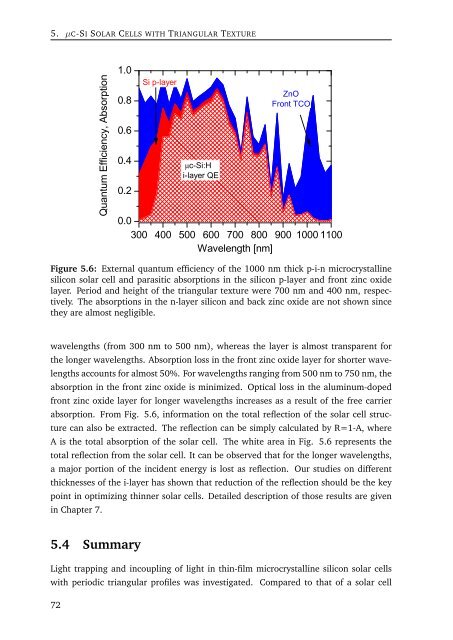Rahul Dewan - Jacobs University
Rahul Dewan - Jacobs University
Rahul Dewan - Jacobs University
Create successful ePaper yourself
Turn your PDF publications into a flip-book with our unique Google optimized e-Paper software.
5. µC-SI SOLAR CELLS WITH TRIANGULAR TEXTURE<br />
Q u a n tu m E ffic ie n c y , A b s o rp tio n<br />
1 .0<br />
0 .8<br />
0 .6<br />
0 .4<br />
0 .2<br />
S i p -la y e r<br />
µc -S i:H<br />
i-la y e r Q E<br />
Z n O<br />
F ro n t T C O<br />
0 .0<br />
3 0 0 4 0 0 5 0 0 6 0 0 7 0 0 8 0 0 9 0 0 1 0 0 0 1 1 0 0<br />
W a v e le n g th [n m ]<br />
Figure 5.6: External quantum efficiency of the 1000 nm thick p-i-n microcrystalline<br />
silicon solar cell and parasitic absorptions in the silicon p-layer and front zinc oxide<br />
layer. Period and height of the triangular texture were 700 nm and 400 nm, respectively.<br />
The absorptions in the n-layer silicon and back zinc oxide are not shown since<br />
they are almost negligible.<br />
wavelengths (from 300 nm to 500 nm), whereas the layer is almost transparent for<br />
the longer wavelengths. Absorption loss in the front zinc oxide layer for shorter wavelengths<br />
accounts for almost 50%. For wavelengths ranging from 500 nm to 750 nm, the<br />
absorption in the front zinc oxide is minimized. Optical loss in the aluminum-doped<br />
front zinc oxide layer for longer wavelengths increases as a result of the free carrier<br />
absorption. From Fig. 5.6, information on the total reflection of the solar cell structure<br />
can also be extracted. The reflection can be simply calculated by R=1-A, where<br />
A is the total absorption of the solar cell. The white area in Fig. 5.6 represents the<br />
total reflection from the solar cell. It can be observed that for the longer wavelengths,<br />
a major portion of the incident energy is lost as reflection. Our studies on different<br />
thicknesses of the i-layer has shown that reduction of the reflection should be the key<br />
point in optimizing thinner solar cells. Detailed description of those results are given<br />
in Chapter 7.<br />
5.4 Summary<br />
Light trapping and incoupling of light in thin-film microcrystalline silicon solar cells<br />
with periodic triangular profiles was investigated. Compared to that of a solar cell<br />
72

















